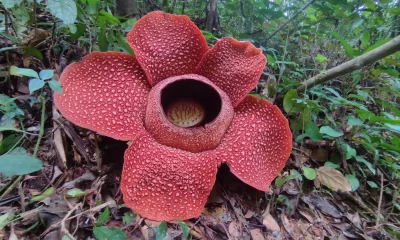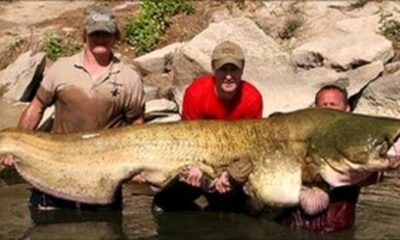
Nature
10 Biggest Holes In The World
Human beings are the forever seekers of knowledge. They know no bounds, whether it is earth or sky, and are always open to discoveries. Humans have dug since ages and have found the remains of our prehistoric cultures, infrastructures and species. It all has begun with a single idea to dig a hole in the ground.
In this article, we will come across 10 biggest holes in the world, where humans literally dug deeper in search of the knowledge of what actually lies beneath the earth.
10. Devil’s Sinkhole
Location: Rockspring, Texas
Depth: 400 feet
The Devil’s Sinkhole is a remarkable 400 feet deep and has an opening of 40*60. It has been a registered national natural landmark since 1985. The Devil’s Sinkhole was named thus in 1876 by the wives of Ammon Billings along wiith other men who found this hole after a meeting with the Indians.
This sinkhole is considered to be the largest single-chamber caverns in Texas. Due to its huge size and rumours that numerous bats live in this sinkhole, many cave explorers in the USA find this place amusing and interesting.
Did You Know?
One of the very first explorers to have stepped into this sinkhole was HS Barber and his name has been carved in the cave with the date October 19, 1889.
9. Diavik Diamond Mine
Location: Canada
Depth: 600 feet
The Diavik Diamond mine is owned by Rio Tinto and the Dominion Diamond Corporation. It is located on east island, an island that is present in Lac de Gras, Canada. This hole was once an open pit and later was converted into an underground mine. The works on this mine started in 2010 and finished in 2012.
The Diavik Diamond Mine is the biggest hole in Canada and produces about 6-7 million carats every year! In the year 2018, this mine broke its very own record and unearthed one of the largest diamonds in the world which weighed a massive 522 carats. However, earlier in 2015, a 187.7 carats Diavik Foxfire diamond was also unearthed in the same mine.
Did You Know?
This mine contains a whopping 18.1 million tons of ore reserves in some of the highest-grade pipes in the world!
8. Dean’s Blue Hole
Location: Clarence Town, Long Island
Depth: 633 feet
A bluehole is referred to as a hole that is filled with water and the entry point of which is located beneath the surface. The Dean’s Blue hole is one of the biggest holes and has a depth of about 663 feet. It is located in the Clarence Town of Long Island.
Where an average hole is estimated to be somewhere around 360 feet, the Dean’s Blue hole, with its massive depth of over 600 feet has now become a great attraction for diving and snorkelling experiences. Since the water is very clear, the visibility reaches up to 30 metres. Since the Blue hole is closed on all sides, wind is not able to reach it and so there are no waves here. This makes the hole a great place for swimmers who have just begun practicing.
Did You Know?
In an astonishing record that was created in 2010, a man named William Trubridge set two records on the same day. In the first record, he reached a depth of 302 feet without using any fins and in the second one, he dived to a depth of 331 feet in a single breath! During his attempts, William used only his hands and feet for propulsion.
7. Kimberley Diamond Mine
Location: Kimberley, South Africa
Depth: 705 feet
At a depth of 705 feet, the Kimberley Diamond Mine lies in South Africa. This mine is a combination of open pit and underground diamond mine and at the centre of it, there is a ‘Big Hole,’ that is almost half a kilometre wide and has a depth of 215 metres.
This mine has been excavated by hand is believed and claimed to be one of the deepest dug mines. It has yielded some of the world’s largest and most expensive diamonds and has also made the De Beers a very famous name throughout the world.
Did You Know?
As many as 50,000 miners excavated 22.5 tons of rock and produced 2,722 kgs of unpolished diamonds between the years 1871 and 1914 from this mine!
6. The Berkeley Pit
Location: Butte, Montana
Depth: 1,780 feet
Located in Butte, Montana, the Berkeley Pit is 1,780 feet deep. The first 1,000 feet of this hole is filled with toxic water and has high concentrations of toxic chemicals like copper, zinc, sulphuric acid and arsenic. Once an open pit copper mine, the Berkeley Mine has also been helpful in supplying electricity to the entire America!
Tourists who visit the spot can view the mine from a platform that has been built at a distance. There is also another viewing stand from where the onlookers can witness the Pit filling up with water. With an admission fee of $2, this touristy attraction is open to public from March until November.
Did You Know?
Inside the toxic and harsh conditions that prevail in the Berkeley Pit, many fungal and bacterial species have been found. Their adaptability to such extreme conditions have shown that they are immune to cancer and studies to prove the same are underway.
5. Mir Mine
Location: Eastern Siberia, Russia
Depth: 1,722 feet
Discovered in 1955 by Soviet geologists, the Mir Mine is a huge open-pit Kimberlite Diamond mine. It is also known as the Mirny Mine and was found by the soviet geologists during a large-scale expedition to the Yakut ASSR.
This mine is 1,722 feet deep and has been one of the very first developed mines. For 44 long years, works on its surface kept taking place and finally closed in 2001. However, when the USSR collapsed in the 1990s, this mine was taken over by the Sakha diamond company. This company reportedly made yearly profits of $600 million through its diamond sales.
Did You Know?
There have been rumours that this mine has been sucking helicopters from the sky but there have been no confirmed reports of the same till date.
4. Chuquicamata Mine
Location: Santiago, Chile
Depth: 2,790 feet
Popularly going by the name Chuqui, the Chuquicamata Mine has been in operation since the early 1900s. It is believed to be one of the largest open-pit copper mines.
Almost a century old, this copper mine is owned and operated by Codelco, which is the company that by far produces the most copper throughout the world. Currently, works are underway to improve this mine since it is so old. The new mine will consist of four production levels, an access tunnel that will be 7.5 km long, two air-extraction shafts and five clean air injection ramps.
Did You Know?
The renovations that took place in this mine increased its life by atleast 40 years!
3. Icecube Neutrino Observatory
Location: Antarctica
Depth: 7920 feet
The Icecube Neutrino Observatory has a very interesting task to do. From deep below at 7,920 feet within the South Pole ice, this Observatory has been designed to observe the cosmos!
With 86 cables that reach beneath the ice, there are 60 supporting digital optical modules that relay data from the depths to the surface above. These modules hang at depths starting at 4,750 feet all the way down to over 8,000 feet!
Did You Know?
To drill holes for these cables, it took seven long years. These holes were dug in the Southern Hemisphere with a 25,000-pound hot water hose and this hose melted a whopping 200,000 gallons of water per hole!
2. Bingham Canyon Mine
Location: Utah, USA
Depth: 10,560 feet
At 10,560 feet deep, the Bingham Canyon is the world’s biggest man-made excavated open-pit copper mine. It is located near Utah and for the most part, this hole was owned by Kennecott Copper Corp. However, after the oil crisis that took place in 1973, this company was acquired by British petroleum and then sold to Rio Tinto.
The mine operates 24 hours a day, 365 days a year. With over 20 million tons of refined copper ore produced in the past 116 years, it’s one of the top performing mines in the world and has provided more wealth for the state of Utah than any other company.
Did You Know?
Kennecott Utah Copper Corp is a subsidiary of Rio Tinto that operates the Bingham Canyon. This place has over 2,400 people that work here!
1. Kola Superdeep Borehole
Location: Russia
Depth: 39,600 feet
The3 Kola Superdeep Borehole is the biggest hole in the world with a depth of a massive 39,600 feet. It lies below a small, nondescript rusty cap in Murmansk, Russia, reaching a whopping 12 kilometres (7.5 miles) into the Earth’s crust.
The story of the Kola Superdeep Borehole started back in the early-1960s as the space race was heating up and the drilling started as result of curiousity and the cold war between USA and Russia that how far can one dig. Unlike the US project defuned in 1966, the USSR was able to keep drilling from around 1970 until 1994, creating the Kola Superdeep Borehole, the deepest hole.
The project was officially terminated in 2005, leaving only a rusted metal cap as a marker of its existence.
Did You Know?
The drilling was stopped because it was believed that the Russians had reached hell. A fundamentalist group in Russia claimed that the well hit a hollow cavity and extremely hot temperatures. Scientists lowered a microphone down the borehole and heard the agonized screams of millions of burning souls.
Trisha Katyayan is an experienced journalist who has print-media background and loves to research, organize and curate factual information in a presentable way.
















